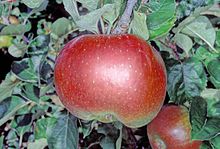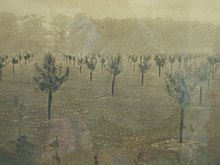Bramley apple
| Malus domestica (Bramley's Seedling) | |
|---|---|
 Bramley's Seedling apples, British Columbia, Canada | |
| Cultivar | Bramley's Seedling |
| Origin | Southwell, Nottinghamshire, England, UK, 1809[1] |
Malus domestica (Bramley's Seedling, commonly known as the Bramley apple, or simply Bramley, Bramleys or Bramley's) is an English cultivar of apple that is usually eaten cooked due to its sourness. The variety comes from a pip planted by Mary Ann Brailsford. The Concise Household Encyclopedia states, "Some people eat this apple raw in order to cleanse the palate, but Bramley's seedling is essentially the fruit for tart, pie, or dumpling."[2] Once cooked, however, it has a lighter flavour. A peculiarity of the variety is that when cooked it becomes golden and fluffy.
Tree[edit]

Bramley's Seedling apple trees are large, vigorous, spreading and long-lived. They tolerate some shade. The apples are very large, two or three times the weight of a typical dessert apple. They are flat with a vivid green skin that becomes red on the side that receives direct sunlight.[2] The tree is resistant to apple scab and mildew and does best when grown as a standard in somewhat heavy clay soil.[2] It is a heavy and regular bearer, and as a triploid, it has sterile pollen. It needs a pollinator but cannot pollinate in return, so it is normally grown with two other varieties of apple for pollination. It has won many awards[3] and currently holds the Royal Horticultural Society's Award of Garden Merit (H4).[4]
Most of the stock of Bramley's Seedling commercially available is slightly different in its growth habit and other characteristics from the original tree, probably because of a chance mutation (or mutations) that occurred unnoticed over the years. Plants produced from the still-surviving (then 180-year-old) tree by tissue culture in 1990 have proved to be much more compact and free-branching than the widely available commercial stock. The cloning work was done by scientists at the University of Nottingham, including Professor Edward Cocking, because the original tree was suffering from old age and was under attack by honey fungus. Twelve of the cloned trees now grow in the University grounds; one was also planted beside the old tree at Southwell, but was cut down when it was 10 years old.[5]
History[edit]

The first Bramley's Seedling tree grew from pips planted by Mary Ann Brailsford in her garden when she was a young girl in Southwell, Nottinghamshire, UK in 1809. Mary left the house when she married and possibly never saw the apples that were produced. She died in 1852 never knowing that "her" seedling was to become famous.[6] The tree she had planted in the garden was later included in the purchase of the cottage by a local butcher, Matthew Bramley, in 1846. In 1856, a local nurseryman, Henry Merryweather, asked if he could take cuttings from the tree and start to sell the apples. Bramley agreed but insisted that the apples should bear his name.
On 31 October 1862, the first recorded sale of a Bramley was noted in Merryweather's accounts. He sold "three Bramley apples for 2/- to Mr Geo Cooper of Upton Hall". On 6 December 1876, the Bramley was highly commended at the Royal Horticultural Society's Fruit Committee exhibition.
In 1900, the original tree was knocked over during violent storms; it survived, and is still bearing fruit two centuries after it was planted. However, it was reported in 2016 that the tree was suffering from a fungal infection and may be dying.[7] The variety is now the most important cooking apple in England and Wales, with 13.5 square miles, 95% of total culinary apple orchards in 2007.[8]
The Bramley is almost exclusively a British variety; however, it is also grown in Ireland. Bramleys are produced by a few United States farms,[9] and can be found in Canada, Australia[10] and Japan.[11]
The town of Southwell hosts many celebrations of the Bramley Apple, including the Bramley Apple Festival launched in 2011.[12] On the third Saturday in October, Southwell Minster hosts the Opening Ceremony and the Food & Drink Festival. The Bramley Apple Inn is located just a few doors away from the original apple tree,[13] which is considered to be a town treasure. In 2018, 27 Church Street was bought by Nottingham Trent University to preserve the building and the tree for posterity. The tree can be visited by prior appointment.
A blue plaque on the house in Southwell now commemorates the apple,[14] and in 2009 a window commemorating the 200th anniversary of the planting of the tree was installed in Southwell Minster.[15]

As a young man Henry Merryweather worked as a gardener on the nearby Norwood Park Estate, and when John Ralph Starkey bought the hall, gardens and pasture in 1880, he turned to Henry Merryweather for advice about which apples and fruit he should be planting on his acreage. The Bramley Apple was suggested and the first commercial orchard of Bramley was established in 1910[16] at Maythorne Orchard, close to the Lower Kirklington Road on what is now a Golf course.[17]
Armagh Bramleys[edit]
Bramley apples from County Armagh enjoy Protected Geographical Indication status within the European Union.[18] The apples have a tarter taste than those grown in England, and over 40,000 tonnes are produced annually.[18]
Cooking[edit]
Bramleys work well in pies, cooked fruit compotes and salads, crumbles, and other dessert dishes. They are also used for chutneys but only form a base for cider, due to their acidity. Whole Bramley apples, cored and filled with dried fruit, baked, and served with custard is an inexpensive and traditional British dessert. Bramleys are also used for apple sauce.
Regardless of the dish, Bramley apples are generally cooked in the same basic way. First the fruit is peeled and then sliced, and the pieces covered in lemon juice (or some other acidic juice) to stop them turning brown. Sugar is often added. In pies and crumbles, the fruit is simply covered with the topping and baked; the moisture in the apples is sufficient to soften them while cooking. The flavour may be spiced, according to taste, with cloves, mixed spice or cinnamon. To make apple sauce, the apples are sliced and then stewed with sugar and lemon juice in a saucepan.
Bramley's Seedling apples are favoured for producing a jelly which is very pale in colour.[19] Because the tree is a heavy cropper and liable to glut, it is a fine candidate for the domestic production of fruit wine, alone or with other fruits, and cider if mixed with a sweeter Cox or similar.
References[edit]
- ^ National Fruit Collection, retrieved 11 November 2015
- ^ a b c The Concise Household Encyclopedia (ca. 1935), Amalgamated Press Ltd, London
- ^ Bramley Apples website: History Archived 2015-08-29 at the Wayback Machine accessed 17 January 2010
- ^ RHS Plant Finder 2009–2010. Dorling Kindersley. 2009. p. 469. ISBN 978-1-4053-4176-9.
- ^ Science Daily website: "Turning back the clock to save the Bramley apple" (3 April 2009) accessed 17 January 2010
- ^ "Brailsford, Mary Ann (bap. 1791, d. 1852), originator of the Bramley's Seedling apple". Oxford Dictionary of National Biography (online ed.). Oxford University Press. doi:10.1093/ref:odnb/57264. ISBN 978-0-19-861412-8. Retrieved 2020-11-22. (Subscription or UK public library membership required.)
- ^ "Original Bramley apple tree in Southwell is dying". BBC. 2016-07-19. Retrieved 2016-07-19.
- ^ "Archived copy" (PDF). Archived from the original (PDF) on 2007-06-09. Retrieved 2007-03-19.
{{cite web}}: CS1 maint: archived copy as title (link) DEFRA Orchard fruit survey 2007 - ^ "Bramley's Seedling apple trees". Retrieved 2019-05-24.
- ^ "Bilpin Springs Orchard, grower of Bramley apples in NSW Australia".
- ^ "ブラムリーとは 【小布施屋】信州小布施のりんご|ジャム栗ブラムリー". obuse-ya.jp. Retrieved 22 August 2015.
- ^ Bramley apple festival tickles the tastebuds. Chad, 2 November 2016, p.24. Accessed 1 February 2022
- ^ [1] BBC visits the original Bramley apple tree
- ^ "Mary Anne Brailsford and Henry Merryweather blue plaque in Southwell". Open Plaques. Retrieved 22 October 2011.
- ^ "Minster's apple window completed". London: BBC. 2009-03-16.
- ^ "The English Apple Man, informing consumers about how the apples they buy are grown, harvested and marketed". theenglishappleman.com. Retrieved 2020-10-28.
- ^ Testing, Wai (2017-04-11). "The Starkeys". John Starkey. Retrieved 2020-10-28.
- ^ a b Cassidy, Martin (8 March 2012). "Armagh Bramley growers celebrate special EU status". BBC News Northern Ireland. BBC. Retrieved 12 May 2012.
- ^ Florence White (1952), Good English Food, Jonathan Cape, London.
